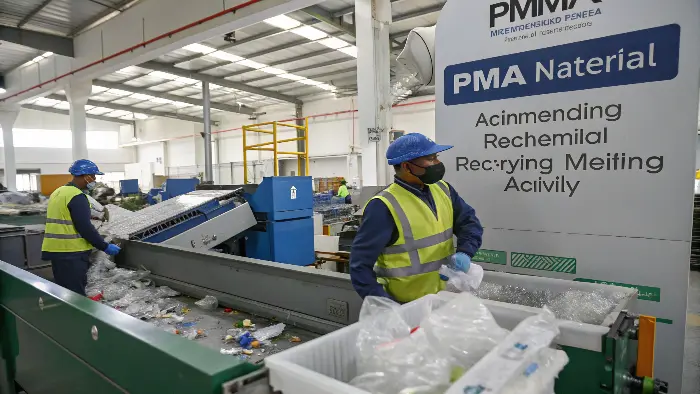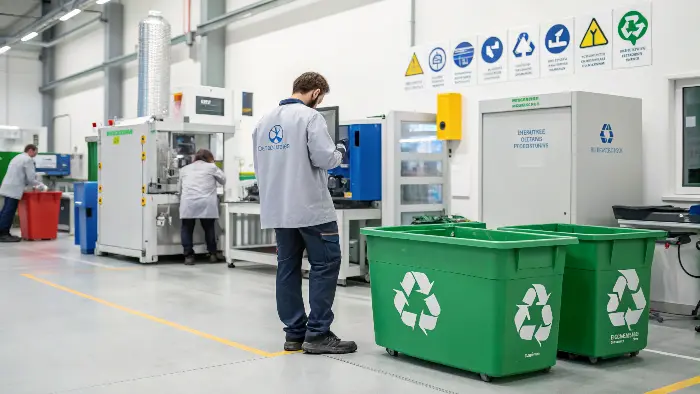Worried about the environmental footprint of your PMMA projects? Traditional manufacturing can be resource-intensive. But what if there were ways to make it greener without sacrificing quality?
Making PMMA injection molding1 sustainable involves boosting energy efficiency2, conserving materials, and embracing robust recycling strategies3. This approach significantly lessens environmental impact while maintaining production excellence.
You know, Alex, as a project manager deeply involved in product development, the topic of sustainability isn’t just a buzzword anymore – it’s a real, pressing concern for many of us. Especially when we’re talking about plastics like PMMA, the questions about environmental impact come up more and more. I’ve been in this industry for a while now, and I’ve seen the shift. We at CavityMold are always looking for ways to "Master Molding Right," and that includes being responsible. It’s not just about making a good part; it’s about making it well, in every sense of the word. The good news is, there’s a lot we can do to make PMMA injection molding kinder to our planet. It’s all about smart choices in energy, materials, and how we handle waste. Let’s dig into how we can make a real difference.
How can we make injection molding more sustainable overall?
Feeling the pressure to "go green" but unsure how to apply it to injection molding? Traditional methods can be wasteful. The good news is, practical steps exist.
Making injection molding more sustainable involves optimizing energy use with efficient machines, minimizing material waste through careful design and regrind use, and exploring eco-friendlier material options.
So, Alex, when we talk about making injection molding in general – not just for PMMA – more sustainable, it’s really a multi-pronged attack. It’s not one single magic bullet, but a combination of smart strategies. I’ve seen firsthand how these changes can add up.
First off, energy efficiency is a big one. Those molding machines can be power hogs!
- Machine Choice: Modern all-electric injection molding machines are a game-changer. They typically use significantly less energy – sometimes up to 50-70% less – compared to older hydraulic machines. I remember when we upgraded a few of our machines at CavityMold; the drop in our energy bills was noticeable almost immediately! Plus, they’re often quieter and cleaner.
- Process Optimization: This is about fine-tuning everything. We look at barrel heating – can we optimize insulation or use more efficient heaters? Cooling is another area; optimizing cooling channel design in the mold and using efficient chillers can save a lot. Shorter cycle times, where feasible without compromising part quality, also mean less energy consumed per part.
Then there’s material conservation. Plastic waste is a huge concern, right? - Reducing Scrap & Regrind: Minimizing rejects and runner waste is key. Using hot runner systems in molds, where possible, eliminates the sprue and runner, so all the plastic goes into the part. When we do have runners or rejected parts, grinding them up (regrind) and carefully blending a controlled percentage back into virgin material (where the application allows) is standard practice. Of course, for PMMA, especially clear grades, the use of regrind needs careful control to maintain optical properties.
- Design for Manufacturing (DFM): Designing parts smartly from the outset can reduce material usage – think thinner, yet strong, walls where appropriate.
Finally, exploring sustainable materials is gaining traction. This includes recycled content polymers (like rPMMA) or even bio-based plastics where suitable for the application. It’s an evolving field, but one we’re watching closely. It’s all about continuous improvement, a core value at CavityMold. We’re always asking, "How can we do this better and greener?"Is injection molding inherently energy efficient?
Wondering if your chosen manufacturing process is an energy glutton? Injection molding’s efficiency can vary wildly. Understanding the factors helps you make informed, greener choices.
Injection molding isn’t inherently energy-efficient or inefficient; its efficiency depends heavily on machine type (electric vs. hydraulic), process optimization, mold design, and the material being processed.
!
That’s a really good question, Alex. Is injection molding, as a process, an energy hog or a model of efficiency? The honest answer is… it depends. It’s not black and white. I’ve seen operations that are surprisingly lean on energy, and others – well, let’s just say their power meters spin like crazy!
The biggest factor, as I touched on before, is the type of injection molding machine. - Hydraulic Machines: These have been the workhorses for decades. They use hydraulic pumps to generate the force needed for clamping and injection. The catch is, these pumps often run continuously, even when no direct work is being done, consuming energy.
- All-Electric Machines: These use servo motors for each movement (injection, clamping, plasticizing, ejection). The beauty here is that the motors only draw significant power when they’re actually performing an action. This makes them much more energy-efficient, especially for PMMA parts that might have longer cooling times where a hydraulic machine would just be idling and burning power. The precision of electric machines can also lead to fewer rejects, saving energy and material indirectly.
- Hybrid Machines: These try to offer the best of both, often using electric for the screw drive (plasticizing) and injection, and hydraulic for clamping.
Beyond the machine itself, process optimization is crucial for energy efficiency, especially with PMMA. - Barrel Temperature: Overheating the PMMA melt wastes energy and can degrade the material. Proper temperature control and insulation are key.
- Cycle Time: Minimizing cycle time (while maintaining part quality) means more parts per hour for the same (or less) energy input per part. Efficient mold cooling is a huge part of this. I once worked on a PMMA project where redesigning the mold’s cooling channels shaved several seconds off the cycle time, which, over a long production run, added up to significant energy savings.
- Auxiliary Equipment: Don’t forget dryers, chillers, and material handling systems. Efficient, well-maintained auxiliaries contribute to overall energy savings. For PMMA, proper drying is essential, and an inefficient dryer can be a real energy drain.
So, injection molding can be very energy efficient, but it takes deliberate effort in machine selection, process control, and mold design. It’s something we actively manage at CavityMold.Is PMMA material actually recyclable?
Concerned about plastic waste from your PMMA parts ending up in landfills? The recyclability of PMMA is a common question. Good news: it can be recycled!
Yes, PMMA is a thermoplastic and is recyclable. It can be reprocessed through mechanical recycling (melting and reforming) or advanced chemical recycling (breaking down to monomer).

This is a fantastic question, Alex, and one that’s increasingly important. The short answer is: Yes, PMMA is recyclable! Being a thermoplastic, PMMA (polymethyl methacrylate) can be melted and reformed, which is the basis of most recycling processes. This is a huge plus from an environmental perspective.
There are generally two main routes for PMMA recycling:
- Mechanical Recycling: This is the most common method. It involves:
- Collection and Sorting: Gathering PMMA waste and separating it from other plastics and contaminants. This is often the biggest hurdle for any plastic recycling. Clean, well-sorted streams are essential.
- Grinding/Shredding: The sorted PMMA is chopped into smaller flakes or pieces.
- Washing and Drying: To remove any dirt, labels, or residues.
- Melting and Extrusion/Pelletizing: The clean flakes are melted down and then typically extruded into strands that are cut into pellets (recycled PMMA or rPMMA). These pellets can then be used to manufacture new products.
I’ve seen some really innovative companies take PMMA off-cuts from signage makers, for example, and turn them into beautiful recycled PMMA sheets.
- Chemical Recycling (or Advanced Recycling): This is a more complex but very promising approach. It involves breaking the PMMA polymer back down into its original monomer, methyl methacrylate (MMA). This process, often called depolymerization, can produce MMA that is virtually identical in quality to virgin MMA. This "re-monomer" can then be re-polymerized to create new PMMA with no loss of properties. This is fantastic for high-purity applications where mechanically recycled material might not be suitable. It’s like hitting the reset button on the plastic!
The challenge with PMMA recycling, like with many plastics, lies in establishing efficient collection and sorting infrastructure and ensuring that the recycled material finds viable end markets. For us at CavityMold, if a client has a project where using rPMMA is feasible and desirable, we’re certainly open to exploring that. The "insights" about exploring sustainable materials like recycled PMMA are spot on – it’s about creating those closed-loop recycling systems where possible.So, is injection molding environmentally friendly then?
Torn between the benefits of injection molding and its potential environmental impact? It’s not a simple yes or no. The "greenness" depends heavily on practices.
Injection molding’s environmental friendliness depends on choices: energy-efficient machines, material conservation, PMMA recycling, and responsible waste management. With conscious effort, its impact can be significantly minimized.

This is the million-dollar question, isn’t it, Alex? Is injection molding, and specifically PMMA injection molding, environmentally friendly? My take, after years in this field, is that it can be, but it requires conscious effort and a commitment to best practices. It’s not inherently "bad," but it’s also not automatically "green" without thoughtful management.
Think about what we’ve discussed:
- Energy Consumption: We know that older hydraulic machines can be energy-intensive. But with modern all-electric machines and optimized processes, we can drastically reduce energy use per part. Using renewable energy sources, as your insights suggest, is another big step forward that some forward-thinking companies are taking. Imagine a molding facility powered largely by solar – that’s a game-changer!
- Material Waste: Injection molding can be very efficient in terms of material utilization, especially with hot runner systems that eliminate runner waste. For PMMA, the ability to recycle scrap internally (regrind) or send it for external recycling (both mechanical and chemical) is a huge plus. The key is minimizing virgin material consumption and maximizing reuse or recycling. The idea of exploring bio-based PMMA, also from your insights, is another avenue that could reduce reliance on fossil fuels for feedstock.
- Recycling & End-of-Life: The recyclability of PMMA itself is a strong point. If we can design PMMA products for easier disassembly and improve collection systems, we can significantly improve its circularity.
- Process Emissions: Modern molding facilities, when well-maintained, have minimal direct air emissions. The main environmental burden often comes from the energy consumed and the lifecycle of the plastic material itself.
I often think about the Life Cycle Assessment (LCA) of a product. Injection molding is just one part of that lifecycle. How the raw PMMA is produced, how the product is transported, used, and eventually disposed of or recycled – all these factors contribute to its overall environmental footprint.
At CavityMold, our slogan "Master Molding Right" pushes us to consider these aspects. We aim to optimize our processes not just for quality and cost, but also for reduced environmental impact. So, while no manufacturing process is entirely without impact, injection molding, when done responsibly with materials like PMMA, can be a highly efficient and relatively sustainable way to produce a vast array of useful products. It’s about continuous improvement and making smart, responsible choices every step of the way. It’s not perfect, but we are definitely making strides! 🔥Conclusion
Sustainable PMMA molding is achievable! Focus on energy-efficient machines, material conservation, and robust PMMA recycling to significantly reduce environmental impact and meet modern manufacturing demands.
-
Explore sustainable practices for PMMA injection molding to reduce environmental impact while maintaining quality. ↩
-
Learn about innovative ways to enhance energy efficiency in manufacturing, crucial for sustainability. ↩
-
Discover effective recycling strategies for PMMA to minimize waste and promote sustainability in the industry. ↩
